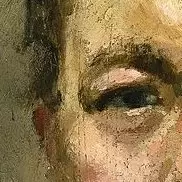Mark Tobey’s animated matrices of brushed line, like the mature works of Jackson Pollock, are allover compositions. That is, unlike conventional representational paintings, they have no discernable center of focus, no single emphasized portion. Even Cubist works maintain vestiges of pictorial illusionism through an increased density of form at their centers. Yet in viewing a work such as Advance of History, the eye moves easily from edge to edge without halting at any particular configuration, dipping, plunging, swirling, and doubling back to pursue the network of dynamic strokes that expand and breathe on the white surface of the paper. The support thus becomes but a portion of a composition that seems to extend beyond the physical limitations of edges or frames.
Although the development of allover compositions in abstract painting is often associated with Pollock, Tobey in fact exhibited works without compositional focus or orientation as early as 1944, two years before Pollock made his first allover painting. In 1935 Tobey introduced his white writing, the characteristic network of white line that covers the surfaces of his works. This innovation followed Tobey’s discovery of Oriental traditions of ink brushwork in China and Japan, where he found himself “freed from form by the influence of the calligraphic.”² The spontaneity and energy conveyed in his first white writing compositions is still evident in the Peggy Guggenheim work, executed nearly thirty years later. But the frenetic impulses of line in early examples, such as Broadway Norm of 1935, have subsided into the more intricate and delicate fabric of lines of varying widths, densities, and color of
Elizabeth C. Childs
It’s a schooner.
You dumb bastartd
Edit: And before anyone thinks I’m being a jerk for no reason: https://youtu.be/sahnApE0I7c?si=_RLTRuvkPEirSjEN
Edit 2: Also, hats off to your username, or should I say arms off…


